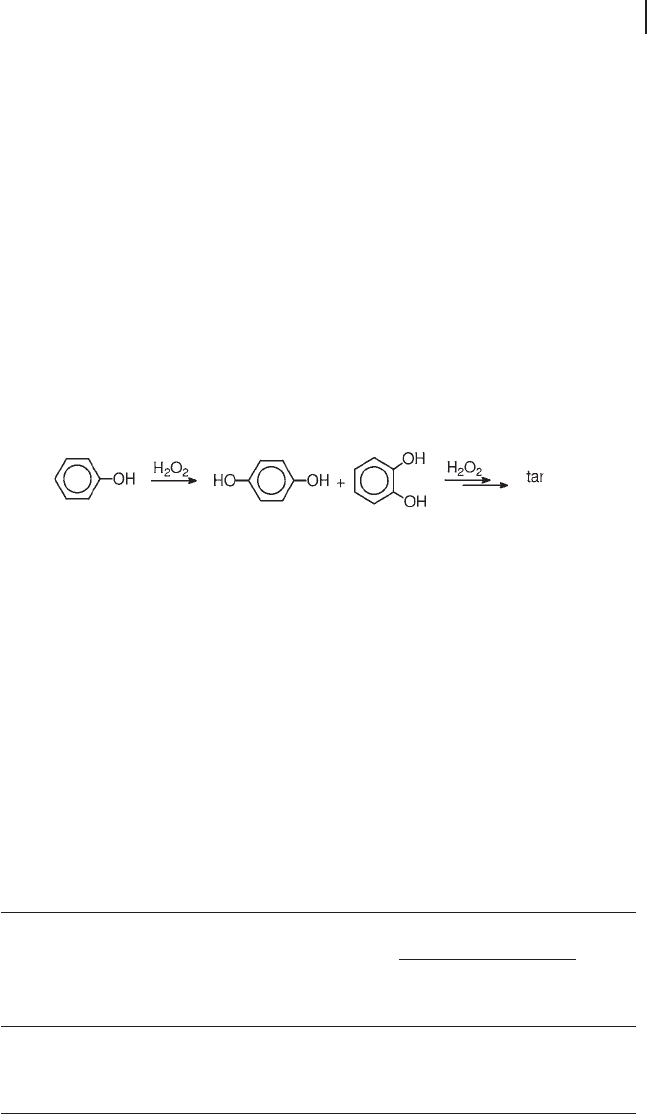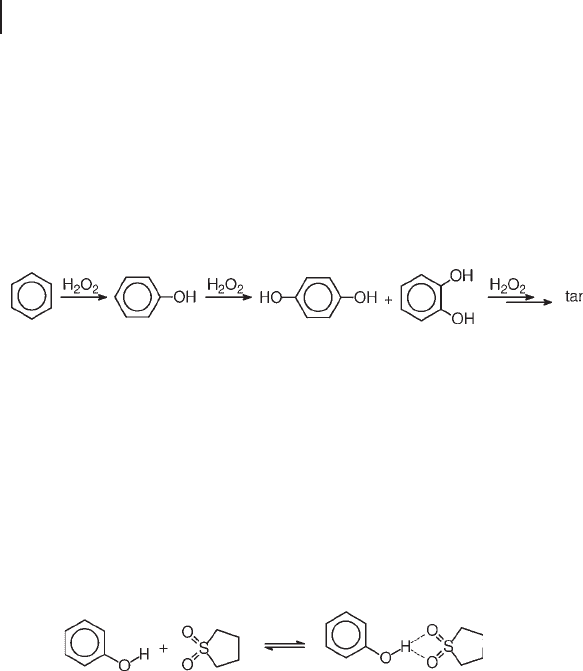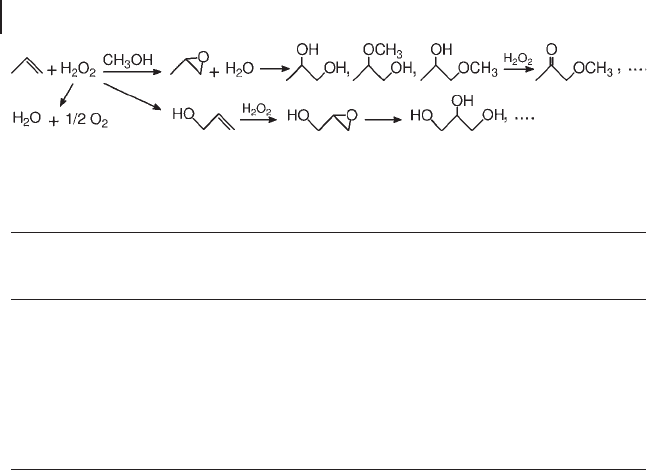Jackson S.D., Hargreaves J.S.J. Metal Oxide Catalysis
Подождите немного. Документ загружается.


710 18 Titanium Silicalite-1
bonds, are inert. The presence of electron - withdrawing groups in 1 - chlorohexane
and methyl heptanoate strongly decreases hydroxylation while orienting the attack
on the remote methylene groups. Consistently, no dihydroxylation is observed
under the conditions of Table 18.2 , and it is negligible on C
8
–
C
12
n - paraffi ns. Both
the absence of consecutive hydroxylation and remote oxyfunctionalization reveal
the electrophilic properties of the active species.
Evidence on the latter was obtained by the use of additives, substrate probes and
labeled molecules. The addition of small amounts of protonic acids promoted
hydroxylation. Alkali metal salts and basic compounds produced the opposite
effect, with inhibition or complete deactivation of the catalyst, depending on the
amount used. The subsequent addition of hydrochloric acid restored the initial
activity, showing that inhibition and deactivation by salts and bases are completely
reversible phenomena [24, 29] . On these grounds, the active species could be
identifi ed as a fairly acidic Ti hydroperoxide or an oxidant, still unknown, produced
by its further transformation [24] . However, the involvement of Ti
–
OOH as the
active species of a heterolytic mechanism is not consistent with the results of the
competitive hydroxylation of aromatic and aliphatic C
–
H bonds, pointing instead
to a homolytic pathway.
Two types of substrate probe, cis - and trans - 1,3 - dimethylcyclopentane and
ethyl - and 2 - propylcyclopropane, were used to shed light on mechanistic details of
the hydroxylation step [30] . In the use of the fi rst two probes, the participation of
Ti
–
OOH species in a concerted mechanism would predict either the retention or
the inversion of confi guration at the chiral center, while the stereochemistry of a
homolytic mechanism would be determined by the competition between the
epimerization of the transient tertiary carbon radical and C
–
O formation (Scheme
18.1 ). In the hydroxylation of cyclopropyl probes, the cyclopropylcarbinyl radical
clock can either rearrange to ring - opened 3 - buten - 1 - yl radical before being trapped
or rebound with the hydroxyl carrier to yield the alcohol product directly (Scheme
18.2 ). With TS - 1, nearly equal amounts of trans - and cis - 1,3 - dimethylcyclopentanol
were obtained from the fi rst type of probe, while no rearranged products were
obtained with the second ones. These results suggest that the putative radical
intermediate is very short - lived, but not short enough to prevent the racemization
of the tertiary carbon radical. Incidentally, it was estimated that epimerization and
cyclopropyl rearrangement occurred with fi rst order rate constants of 10
9
and ca
10
8
s
− 1
, respectively [30, 31] .
The use of radical quenchers and the competitive oxidation of cyclohexane and
cyclohexane - d
12
led to identifi cation of the active species as a Ti - centered radical
Scheme 18.1 Hydroxylation of sterically pure cis - and trans - 1,3 - dimethylcyclopentane.

18.2 Hydroxylation of Alkanes 711
[24] . Actually, BHT (2,6 - di - tert - butyl - 4 - methylphenol), carbon tetrachloride, chloro-
form and dichloromethane neither affected the hydroxylation rate nor produced
chlorinated derivatives, thus excluding a free radical mechanism and the presence
of long - lived alkyl radicals, both in the pores of the catalyst and in the external
solution. The primary isotopic effect in methanol and t - butanol was 4.1 and 4.7,
respectively. A k
H
/ k
D
of this magnitude is not compatible with a radical chain oxi-
dation initiated by hydroxyl radicals ( k
H
/ k
D
= 1 – 2), while it is fully consistent with
substantial C
–
H bond cleavage in the transition state by a Ti - centered radical.
On the whole, it is conceivable to postulate an active species that is Ti centered,
has a radical nature and originates from a Ti
–
OOH precursor, through some sort
of reaction which the latter species may undergo. An early mechanistic proposal,
based on a diradical peroxy species, does not match all these conditions (Scheme
18.3 a). This requires that the adsorption of hydrogen peroxide on Ti leads to a
side - on bonded peroxide and, more importantly, implies the splitting of one strong
Ti
–
O bond instead of the weaker peroxidic O
–
O one. The unlikelihood of Ti
–
O
cleavage is confi rmed by the reaction of a Rh peroxide with carbon dioxide, occur-
ring through the insertion of CO
2
into the O
–
O bond, to yield the corresponding
peroxycarbonate [32] .
Scheme 18.3 b illustrates a recent mechanistic proposal. This bears similarities
to the oxygen - rebound mechanism, proposed for the hydroxylation of alkanes by
high - valent transition metal species in biomimetic and enzymatic systems [31, 33,
34] . The generation of the active species and other implications of the mechanism
are discussed in detail in Section 18.11.3 .
Scheme 18.2 Hydroxylation of ethylcyclopropane.
Scheme 18.3 (a) C
–
H hydroxylation by Ti( η
2
–
O
2
);
(b) C
–
H hydroxylation by oxygen - rebound - like mechanism.

712 18 Titanium Silicalite-1
18.2.2
Other Ti - Zeolites
Only TS - 2 and Ti,Al - β , among other Ti - zeolites, catalyze the hydroxylation of
alkanes. The close similarity of TS - 2 with TS - 1 suggests analogous catalytic proper-
ties. The somewhat poorer performances reported in the literature probably refl ect
the poor quality of early catalysts, containing extra - framework impurity Ti species.
Ti,Al - β , on the other hand, is defi nitely inferior to TS - 1, except in the hydroxylation
of bulky alkanes (Table 18.4 ) [35] . Interestingly enough, Ti,Al - β catalyzes the
hydroxylation of both sec - C
–
H and t - C
–
H in the same molecule, though the reac-
tivity of the latter is signifi cantly higher [36] . In 1,2 - and 1,3 - dimethylcyclohexanes,
equatorial C
–
H bonds are more reactive than those at axial positions, probably
because there is less hindrance in the approach to the active species. The direct
link between the hydrophobicity of the sample used and catalytic performance is
of mechanistic interest [37] .
18.3
Hydroxylation of Aromatic Compounds
The synthesis of phenolic compounds, including the industrial production of a
major commodity such as phenol, has historically been achieved by the transfor-
mation of pre - existing aromatic functional groups. The generally poor selectivity
of direct hydroxylation routes is especially evident with molecular oxygen as the
oxidant, though sometimes relatively high yields have been claimed. The use of
hydrogen peroxide appears more promising, and is characterized by greater selec-
tivity. Actually, in the early 1970s Brichima and Rh ô ne - Poulenc commercialized
two industrial processes for the hydroxylation of phenol with H
2
O
2
. The develop-
ment of TS - 1 and Fe - ZSM - 5 opened new routes to selective hydroxylation pro-
cesses with hydrogen peroxide (EniChem, hydroxylation of phenol) and nitrous
oxide (Solutia, hydroxylation of benzene), respectively.
Table 18.4 Hydroxylation of alkanes on Ti,Al - β and comparison with TS - 1 [35] .
Alkane
Ti,Al - β
TS - 1
TON (mol/mol
Ti
) Selectivity (%
based on H
2
O
2
)
TON
(mol/mol
Ti
)
Selectivity (%
based on H
2
O
2
)
n - hexane 0.5 32 48.5 100
cyclohexane 2.3 51
a)
–
methylcyclohexane 5.2 88
a)
–
a Products below detection limits.

18.3.1
Hydroxylation of Phenol
18.3.1.1 Titanium Silicalite - 1
Normally in a review the hydroxylation of benzene should come before that of
phenol. The latter, however, has been the center of interest of most studies, par-
ticularly of early ones, whereas benzene has been considered often just for the
completeness of the range of substrates. On these grounds, an exception for
phenol is justifi ed.
Hydroxylation is a consecutive reaction in which low conversion has to be main-
tained, to prevent the over - oxidation of catechol and hydroquinone to tars (Equa-
tion 18.5 ). This is normally achieved by operating with an excess of phenol over
hydrogen peroxide. The greater the H
2
O
2
: phenol ratio allowed in the feed, without
penalty to the selectivity, the greater the effectiveness of the catalysts (Table 18.5 )
[5, 38, 39] . A stirred reactor is normally preferred, though the use of the fi xed bed
type has sometimes been reported [40 – 42] .
(18.5)
In aqueous acetone and methanol, TS - 1 shows superior performance than in
t - butanol or just water. The solvent has also a major effect on the catechol : hydro-
quinone ratio (see below). This varies in the range 0.5 – 1.3, which is some way
from the value of 2 expected for a statistical attack at the ortho and para positions
(Table 18.5 , entries 1 and 2). Yet, under practical conditions, the main component
of the reaction mixture could be phenol instead of the putative solvent and, under
such conditions, the product ratio approaches unity.
The yields based on hydrogen peroxide are comparable to those obtained with
acid catalysts, but at six - fold higher conversion (Table 18.4 , entries 1 and 3). The
most important parameters for the yield are the operating temperature and the
purity, concentration and crystal size of the catalyst [5, 43] . Yields increased, at
the expense of tar production, up to a maximum of ca 83% at 100 ° C, and then
Table 18.5 Hydroxylation of phenol with hydrogen peroxide.
Catalyst Ortho/para Phenol
conversion (%)
Selectivity Ref.
(% based
on H
2
O
2
)
(% based
on C
6
H
5
OH)
1 TS - 1 0.5 – 1.3 30 82 92 [5]
2 Co
+2
, Fe
+2
2 – 2.3 9 66 79 [39]
3 H
+
1.2 – 1.5 5 85 – 90 90 [38]
18.3 Hydroxylation of Aromatic Compounds 713

714 18 Titanium Silicalite-1
decreased rapidly with further temperature rises. Extra - framework Ti phases
promote non - productive side reactions, for example decomposition of the oxidant
and radical chain oxidations. In general, this applies to any oxidation catalyzed by
TS - 1, but is crucial for aromatic hydroxylation that requires a relatively high tem-
perature. The hydroxylation of phenol, indeed, was proposed as chemical test to
assess the purity of TS - 1 [5, 43, 44] . The concentration of TS - 1 also affects the
yields, owing to greater competition of secondary reactions in the presence of
excess H
2
O
2
and low catalyst contents. Van der Pool and others originally showed,
and other authors confi rmed, that the hydroxylation of phenol is diffusion limited
for crystal sizes larger than 0.3 µ m [45 – 47] .
Experimental data fi t well with kinetic expressions that are fi rst order in both
phenol and hydrogen peroxide [47] . Observed rate constants were signifi cantly
larger in water than in methanol and acetone. This was ascribed to the stronger
adsorption of phenol from an aqueous solution in TS - 1 (Table 18.6 ) [47, 48] . Sur-
prisingly enough, in the presence of methanol or acetone the concentration of
phenol in the pores was about the same as that in the external solution.
An issue of debate is the relative roles of internal and external sites in the cata-
lytic process. The effects of shape selectivity, clearly present in product distribu-
tion, seem to indicate a predominance of intra - porous hydroxylation. However,
the different catechol/hydroquinone ratio in methanol (0.5) and acetone (1.3),
could indicate a signifi cant contribution of sites located on the outer surface of the
crystals, particularly for crystallite sizes < 0.3 µ m. Tuel and others, studying the
time course of the reaction and the solubility of tarry deposits, went further and
concluded that catechol and hydroquinone were produced on different sites, exter-
nal and internal respectively [49] . The effect of acetone and methanol simply
refl ected their ability to maintain external sites clean from tar deposits, which are
soluble in the former and insoluble in the latter. On the other hand, Wilkenh ö ner
and others concluded, with the support of kinetic constants estimated indepen-
dently for internal and external sites, that catechol was also produced in the pores
over the entire reaction profi le, albeit at a lower rate [47] . The contribution of the
outer surface for crystal sizes close to 0.1 µ m ranged from 46% in methanol to
69% in acetone.
Little is known of the active species and the hydroxylation mechanism. It is even
unclear whether the mechanism is homolytic or heterolytic. Accordingly, mecha-
nisms of both types have been proposed (Schemes 18.4 and 18.5 ).
Table 18.6 Henry constants ( K
P
) for the adsorption of phenol in TS - 1.
a)
Solvent K
P
Water 84.4
Methanol 0.7
Acetone 0.6
a Adapted from Ref. [47] . Copyright 2001, with permission of Elsevier.

In the mechanism of Scheme 18.4 , hydroxylation is carried out homolytically by
the same species proposed for alkane hydroxylation [25] . The oxidation of the
cyclohexadienyl intermediate by hydrogen peroxide produces the diphenol and
regenerates the active species, closing the catalytic cycle. Scheme 18.5 illustrates
the heterolytic routes proposed by Wilkenh ö ner and others for hydroquinone and
catechol production, based on cationic peroxy intermediates [47] . Both types of
mechanism, however, are little more than working hypotheses, needing validation
by experimental evidence.
18.3.1.2 Other Ti - Zeolites
TS - 2 was shown to be almost indistinguishable from TS - 1, as predicted by similar-
ity of structures and active sites [46] . Ti - Beta zeolites, with and without Al in the
structure, were less effective than TS - 1. The yields based on hydrogen peroxide,
just above 60%, were typical of rather modest catalysts. Apparently, product selec-
tivity was infl uenced by the Al content. The relatively hydrophilic Ti,Al - β produced
catechol and hydroquinone in nearly equimolar amounts [50] . The Al - free Ti - β
showed a higher catechol selectivity, with an ortho / para ratio of 2 [47] . In both
cases, the greater spaciousness of pores favoured ortho hydroxylation. For a useful
comparison, the ortho / para ratio on medium - pore TS - 1 was 0.77 under analogous
conditions.
Scheme 18.4 Homolytic hydroxylation of phenol by Ti
–
O
•
species.
Scheme 18.5 Heterolytic hydroxylation of phenol by Ti
–
OOH
species. (Adapted from Ref. [47] ; Copyright 1991, with
permission of Elsevier).
18.3 Hydroxylation of Aromatic Compounds 715

716 18 Titanium Silicalite-1
18.3.2
Hydroxylation of Benzene
The hydroxylation of benzene on TS - 1 produces phenol as the primary product
and, by consecutive oxidation, hydroquinone, catechol, benzoquinone and tarry
products (Equation 18.6 ) [5, 30, 51] . The selectivity to phenol generally falls below
50% even at only 3 – 5% benzene conversion. Hydroxylation with a mixture of
hydrogen and oxygen on Pd/TS - 1 proved to be even less effective [52] .
(18.6)
Recently, the use of sulfolane solvent allowed better kinetic control of the oxida-
tion chain, with an increase of the selectivity to 80% or greater, at ca 8% benzene
conversion. The by - products were catechol (7%), hydroquinone (4%), 1,4 - benzo-
quinone (1%) and tar (5%) [53, 54] . According to these authors, a rather stable
complex, formed by hydrogen bonding with sulfolane, promoted desorption and
hindered the re - adsorption of phenol, protecting it from consecutive oxidation
(Equation 18.7 ). Actually, the rate of oxidation of phenol in the presence of sulfo-
lane was only 1.6 times that of benzene, while it was 10 times higher in the pres-
ence of acetone.
(18.7)
The pretreatment of TS - 1 with a solution of ammonium fl uoride and hydrogen
peroxide further increased the conversion (ca 9%) and selectivity. The recovery of
catechol and hydroquinone, by their hydrogenation back to phenol, was also con-
sidered [55] . It is worth noting that, at a threshold yield value of ca 9%, the hydrox-
ylation of benzene could become competitive with the cumene process, considering
that the overall per pass yield in the latter does not exceed 8 – 9%.
Far greater yields were reported for the hydroxylation of benzene under the so -
called triphasic conditions, that is with the solid catalyst, aqueous hydrogen per-
oxide and an immiscible aromatic phase [56] . Others, however, could not reproduce
these results [54] .
Benzene hydroxylation on Ti,Al - MOR was studied by three different groups
[57 – 59] . Despite the spaciousness of its pores, the activity of this catalyst was lower
than that of TS - 1, as expected for a more hydrophilic catalyst. Accordingly, increase
in the Al content caused a decrease in the conversion, probably because of reduced
adsorption of benzene.

18.3.3
Oxidation of Substituted Benzenes
Electron - withdrawing substituents decrease the rate of oxidation, revealing the
electrophilic nature of the oxidant species. Accordingly, negligible or no yields
were reported for the hydroxylation of chlorobenzene, nitrobenzene, benzonitrile,
benzaldehyde and benzoic acid on TS - 1 [5] . Alkyl groups produced contrasting
effects: a rate enhancement by electron donation and a rate decrease by steric and
transport restrictions. In this regard, the size of the methyl group in toluene virtu-
ally compensated for the increase of electron density [5] . For other alkylbenzenes,
the nuclear reactivity trend was in the order: toluene > p - xylene ≥ ethylbenzene >
p - methylethylbenzene, showing again the predominance of steric hindrance [5, 30,
59] . Bulkier substituents suppressed hydroxylation, for example in 2 - propylben-
zene [24] .
The oxidation of alkylbenzenes also produced sec - alcohols and ketones, with no
reaction at tertiary and primary carbons. At variance with the rule that double
bonds are preferentially oxidized over other functionalities, side - chain epoxidation
had to compete with aromatic hydroxylation in the oxidation of α - methylstyrene,
1 - phenyl - 2 - butene and 4 - phenyl - 1 - butene [60] .
Ti - MOR promoted the ring hydroxylation of toluene, ethylbenzene and xylenes
with negligible oxidation of the ethyl side chain [59] . In the same study, however,
and in contrast to earlier ones, a similar result was also reported for TS - 1. No oxi-
dation of benzylic methyls was observed. Cumene yielded mainly the decomposi-
tion products of cumyl hydroperoxide. The oxidation of t - butylbenzene was
negligibly low. The reactivity order, toluene > benzene > ethylbenzene > cumene,
refl ects the reduced steric constraints in the large pores of mordenite. Accordingly,
the rate of hydroxylation of xylene isomers increased in the order para < ortho < meta ,
in contrast to the sterically controlled one, ortho < meta << para , shown on TS - 1. It
is worth mentioning that the least hindered p - xylene exhibited the same reactivity
on either catalyst.
18.4
Oxidation of Olefi nic Compounds
18.4.1
Epoxidation of Simple Olefi ns
The oxidation of olefi ns with aqueous hydrogen peroxide in methanol can produce
several products, by different reaction paths: double bond epoxidation, allylic H -
abstraction, epoxide solvolysis, alcohol and glycol oxidation (Scheme 18.6 ). Nor-
mally, oxide catalysts of Group IV – VI metals are poorly selective, because of their
acidic properties, the inhibition they are subject to in aqueous media and homo-
lytic side reactions with hydrogen peroxide. The only exception concerns the
epoxidation of α , β - unsaturated alcohols and acids, which are able to bind on the
18.4 Oxidation of Olefi nic Compounds 717

718 18 Titanium Silicalite-1
catalyst through the oxygenated functionality. However, TS - 1, a mixed oxide of
silica and titania similar in composition and Ti dispersion, but not structure,
to the Ti/SiO
2
Shell catalyst, unexpectedly showed high activity and selectivity.
Actually, a most remarkable feature of TS - 1 is the smooth and preferential epoxida-
tion of the double bond, over any other functionality that may be present in the
molecule.
18.4.1.1 Titanium Silicalite - 1
Epoxidation occurs in dilute solutions of aqueous hydrogen peroxide and at near
room temperature [61, 62] . The rate is rapid even at H
2
O
2
concentrations of 1%
or lower and at temperatures as low as − 5 ° C. Electron - defi cient olefi ns can also
be oxidized at near room temperature (Table 18.7 ). Preferred solvents are alcohols
and, in general, protic or polar media. The rate of epoxidation decreases in the
solvent order: methanol > ethanol > i - propanol > acetone > acetonitrile > t - butanol,
with a difference greater than one order of magnitude between the two extremes
of the series [62, 63] . An exception could be the oxidation of cyclopentene, for
which acetone and acetonitrile were reported to be less effective than t - butanol
[64] . In the epoxidation of propene, the rates in water were possibly faster than in
methanol, though the rapid decay of the catalyst did not allow unequivocal conclu-
sions. As a matter of fact, water contents up to 50 wt% in methanol produced only
a moderate reduction of the rate, probably because of the lower solubility of
propene in aqueous media (TOF 1 – 2 s
− 1
, at 40 ° C).
Scheme 18.6 Reaction pathways in the oxidation of propene with hydrogen peroxide.
Table 18.7 Epoxidation of linear olefi ns.
a)
Olefi n T ( ° C) t (min) t
1/2
(min)
b)
Conversion (%) Selectivity (%
based on H
2
O
2
)
1 - butene
− 5
60 – 96 96
1 - pentene 25 60 5 94 91
1 - hexene 25 70 8 88 90
cyclohexene 25 90 – 9 –
1 - octene 45 45 5 81 91
allyl chloride 45 30 7 98 92
allyl alcohol 45
c)
35 16 81 72
a Adapted from Ref. [62] . Copyright 1993, with permission from Elevier.
Solvent, methanol; olefi n, 0.90 mol l
− 1
; TS - 1, 6.2 g l
− 1
.
b t
1/2
is the time necessary to 50% H
2
O
2
conversion.
c TS - 1 4.0 g/l

The epoxidation of unhindered olefi ns is nearly quantitative and the incidence
of side reactions is negligible [62] . The epoxide selectivity can be higher than 90%.
The by - products are merely those produced by the acid solvolysis of the oxirane
ring, namely the corresponding glycol and methyl ethers. Basic compounds able
to diffuse inside the pores of TS - 1, such as sodium acetate, sodium hydroxide and
ammonia, decrease the intra - porous acidity generated by Ti
–
OOH species and,
sometimes, by lattice Al impurities. Their addition in parts per million quantities
minimizes the cleavage of the epoxide, thus enhancing the selectivity up to 97 –
98%. Spontaneous hydrolysis, fairly slow but always present in protic media, pre-
vents the achievement of quantitative yields [61] . Further increasing the
concentration of the base gradually decreases the catalytic activity up to complete
inhibition. Bulky tetrapropylammonium hydroxide, unable to diffuse into the
pores of TS - 1, does not affect the epoxidation process at any concentration.
The epoxidation rate is related to the electron density of the double bond, increas-
ing with it. Thus, the epoxidation of propene is much faster than that of ethene.
The formal substitution of one methyl, chloro or hydroxyl group at the allylic posi-
tion of propene results into the reactivity order: 1 - butene > allyl chloride > allyl
alcohol. Methyl substitution on butenes also produces the expected ordering:
2 - methyl - 2 - butene > 2 - methyl - 1 - butene > 3 - methyl - 1 - butene (Table 18.8 ).
However, since epoxidation occurs within pores of cross - section comparable to
that of the olefi n, steric restrictions generally prevail over inductive effects, leading
to anomalous reactivity orders. They result from restrictions to diffusion in the
pores ( reactant shape selectivity ) and to the approach of the double bond to the
active species ( transition state shape selectivity ). The fi rst is suffi cient to explain
18.4 Oxidation of Olefi nic Compounds 719
Table 18.8 Relative rates in the epoxidation of C
4
and C
5
olefi ns.
a)
TS - 1 TS - 1 CH
3
CO
3
H
r
1
/ r
n
Olefi n r
1
/ r
n
b)
Olefi n r
1
/ r
n
b)
1.0
1.0 1.0
0.59
0.13 ca 1.0
0.71
0.87
c
20 – 24
0.17
c)
0.19 20 – 24
2.7
c)
– – 2 0 – 2 4
– –
0.79 240
a Data taken from Refs [62, 65] .
b Averaged values from competition kinetics.
c Epoxidation occurred with complete retention of confi guration.
